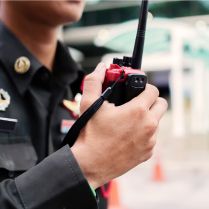How does an Emergency Responder Radio Communications system, or ERRCS, enhance public safety during emergencies?
An Emergency Responder Radio Communications System (ERRCS) significantly enhances public safety and response time during emergencies by ensuring clear and reliable 2-way radio communication among first responders. In crises, every detail counts, and a properly designed and deployed communication system can mean the difference between life and death.
ERRCS allows for ubiquitous radio coverage for first responders in indoor settings such as difficult settings like tall buildings or underground facilities, where regular signals may be weak or absent due to obstructions, construction materials, or distance from the tower. By ensuring proper function of the 2-way radio system which promotes immediate clear communication and better coordination among emergency workers, ERRCS enhances the ability for first responders to do their jobs; reducing response times, enhancing operational effectiveness, and ultimately raising the likelihood of successful outcomes during emergencies.
What are the key components that make an ERRCS work?
An Emergency Responder Radio Coverage System (ERRCS) is a critical infrastructure designed to provide reliable radio coverage for first responders in emergencies. The key components of an ERRCS typically include:
Bi-Directional Amplifiers (BDAs): BDAs amplify the outdoor 2-way radio system signal strength into the building, as well as amplifying the in-building signals back to the tower. This 2-way amplification enables effective two-way communication, even in large or complex structures.
Battery Backup: This ensures the ERRCS continues to function during power outages by providing 12, 24, or more hours of backup power in a rated enclosure.
Passive components: The passive layer consists of the cabling, splitters, couplers, and antennas required to distribute the 2-way radio signals throughout a facility including critical areas such as utility rooms, stairwells, and pump rooms. An effective ERRCS is essential for ensuring the safety and effectiveness of first responders in emergency situations. In times of crisis, clear and reliable communication between response teams can mean the difference between life and death which is why they are included in the fire codes and enforced in many jurisdictions nationwide.
How does ERRCS differ from a carrier wireless Distributed Antenna System (DAS) or booster?
Emergency Responder Radio Communication Systems (ERRCS) and Wireless Carrier Distributed Antenna Systems (DAS) serve different purposes within the wireless communication ecosystem. While both systems aim to enhance signal strength, their primary applications vary significantly. ERRCS, as the name suggests, is designed to ensure mission critical radio coverage for emergency services within buildings. Many jurisdictions enforce the code defined mandates for their deployment to provide reliable communication for first responders throughout the entirety of a facility including the critical areas such as pump rooms, utility spaces, and stairwells.
On the other hand, a carrier wireless DAS is a network of equipment ands antennas with the goal to improve wireless service within a structure or an area. These systems are primarily concerned with boosting the reach and quality of cellular signals for everyday communication needs where people congregate.
In addition to their different applications, DAS and ERRCS also differ in regulatory requirements. As mentioned earlier, ERRCS are mandated by many jurisdictions to ensure adequate emergency communication for first responders. This requirement is found in and the fire codes published by the NFPA (National Fire Protection Association) and IFC (International Fire Code).
On the other hand, carrier DAS installations may require approval from wireless carriers and local authorities for electrical and building permits before being implemented, but their consideration is required by any particular codes at this time. The wireless carrier coordination is of particular concern because a poorly designed, implemented, or maintained system can cause interferences with the existing cellular signals and impact carrier network.
Despite their differences, DAS and ERRCS are important in improving wireless communication but serve different purposes in the built environment for either code compliance for safety, or for the connectivity and convenience of the public. As technology continues to advance, we will likely see further developments in both systems, making them even more efficient and effective.
What are the legal and regulatory requirements for implementing ERRCS in buildings?
The implementation of Emergency Responder Radio Communications Systems (ERRCS) in buildings is governed by fire codes and the application of those by your local Authority Having Jurisdiction (AHJ). To ensure these systems' safe and effective operation, building owners must comply with these codes, including the National Fire Protection Association (NFPA) 72 and 1221 and the International Fire Code (IFC). These regulations stipulate specific standards for system design, performance, coverage, battery backup, and annual testing.
Local jurisdictions may also have additional requirements, so liaising with local authorities or a knowledgeable integrator is critical to ensure full compliance and avoid expensive rework. It's also important to note that failure to meet these requirements can result in penalties and potential legal liability in the event of system failure during an emergency.
The NFPA 72 and 1221 codes provide a comprehensive set of standards for building design, installation, maintenance, and testing ERRCS. These standards are continuously updated to reflect changes in technology and best practices, so it's essential for building owners to stay up-to-date with the latest versions. Additionally, the IFC sets out requirements for fire alarm systems and emergency communications systems, including ERRCS. These codes may also require a Certificate of Compliance (COC) or testing to be accepted by the AHJ before a Certificate of Occupancy (CO) will be issued for the building.
To comply with these regulations, building owners must ensure that their ERRCS meets specific performance requirements. This includes providing adequate signal coverage throughout the building, ensuring that the system is capable of two-way communication, and having a backup power source in case of a power outage. These requirements are essential for ensuring that first responders can communicate effectively during an emergency and receive critical information to help them respond quickly and efficiently.
How is ERRCS testing and maintenance carried out to ensure system reliability?
Emergency Responder Radio Communication System (ERRCS) testing and maintenance are carried out methodically to ensure system reliability. Initially, a comprehensive signal coverage test is conducted to identify the areas of need within the building. Periodic re-testing is then carried out to maintain optimal system performance. Regular maintenance includes visual inspections of equipment, cleaning, and calibration of system components, and functional tests of battery backup systems and alarm tie-ins to the fire alarm system. These activities ensure the system is robust and capable of providing reliable communication during critical emergencies.
Aside from regulatory compliance, another crucial factor in maintaining a reliable ERRCS is proper training and education of its users. All personnel responsible for building maintenance and systems or may need to use the system in case of an emergency should receive thorough training on how to operate it effectively. This includes understanding the different features and functions of the system and proper communication protocols during emergencies.





